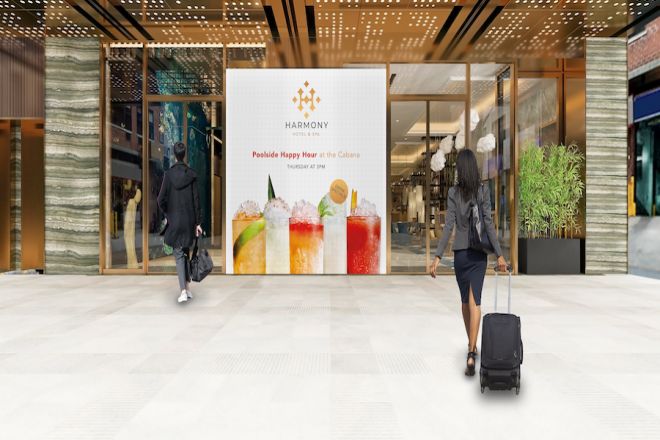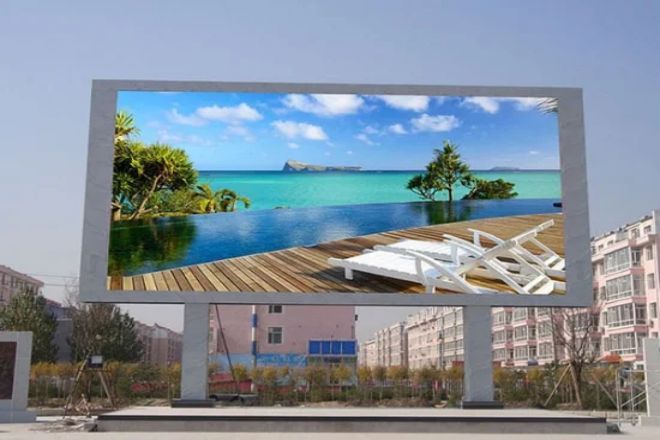مقدمة

في مشهد المدينة الليلي المبهر، شاشات اعلانية خارجية LED تجذب أضواءها الساطعة أنظارًا لا تُحصى، وتصبح جزءًا لا يتجزأ من المدن الحديثة. ولكن، هل تُثير فاتورة الكهرباء الباهظة هذا الإعجاب؟
في مواجهة الضغوط المتزايدة لاستهلاك الطاقة، لا يسعنا إلا أن نسأل: كيف يمكننا تحقيق "تخفيف فاتورة الكهرباء" لشاشات الإعلانات الخارجية LED مع الحفاظ على التأثيرات الإعلانية؟
تهدف هذه المقالة إلى حل هذه المشكلة. سنستكشف بعمق أسرار توفير الطاقة وتخفيض استهلاك شاشات الإعلانات الخارجية بتقنية LED، بدءًا من الابتكار التكنولوجي وصولًا إلى تحسين الإدارة، لنكشف لكم عن سلسلة من الاستراتيجيات الفعّالة لتخفيض فواتير الكهرباء.
سواء كنت من العاملين في مجال الإعلان أو من المهتمين بالبيئة الذين يهتمون بالحفاظ على الطاقة وخفض الانبعاثات، أعتقد أن هذه المقالة يمكن أن تجلب لك الإلهام والمكاسب.
1. ما مقدار الطاقة التي تستهلكها شاشة الإعلانات الخارجية LED؟
يُعد استهلاك الطاقة لشاشات الإعلانات الخارجية بتقنية LED مسألةً معقدةً نسبيًا، إذ يتأثر بعوامل عديدة، منها حجم الشاشة، ودقتها، وسطوعها، ومحتوى العرض، ومدة الاستخدام، وتقنية LED المستخدمة، وكفاءة الطاقة. فيما يلي تحليلٌ مُفصّل لاستهلاك الطاقة لشاشات الإعلانات الخارجية بتقنية LED:
1) نطاق استهلاك الطاقة
1.1). نطاق استهلاك الطاقة الأساسي:
بشكل عام، تتراوح قوة شاشات العرض LED الخارجية (التي تُشير عادةً إلى متوسط استهلاك الطاقة) بين ٢٠٠ و١٥٠٠ واط لكل متر مربع. هذا النطاق واسع نسبيًا، ويعود ذلك أساسًا إلى اختلاف استهلاك الطاقة بين شاشات العرض باختلاف طرازاتها، ودرجات سطوعها، وظروف استخدامها المختلفة.
1.2). نوع محدد من استهلاك الطاقة:
قد يبلغ الحد الأقصى لاستهلاك الطاقة حوالي 800 واط لكل متر مربع، ولكن في الاستخدام الفعلي، يختلف استهلاك الطاقة باختلاف محتوى التشغيل. في الاستخدام العادي، قد يتراوح استهلاك الطاقة الفعلي بين 400 و700 واط لكل متر مربع.
- شاشة عرض LED أحادية اللون أو حمراء اللون:
استهلاك الطاقة منخفض نسبيًا، وقد تصل الطاقة القصوى لكل لوحة إلى حوالي ٢٥ واط. إذا كانت ١٦ لوحة تُشكل مربعًا واحدًا، فإن إجمالي استهلاك الطاقة يتراوح بين ١٥٠ و٢٠٠ واط.
2) العوامل المؤثرة
- سطوع:
كلما زاد سطوع شاشة العرض، زاد استهلاك الطاقة عادةً. لذلك، في الليل أو في بيئة ذات إضاءة خافتة، يُمكن خفض السطوع بشكل مناسب لتقليل استهلاك الطاقة.
- محتوى التشغيل:
عند تشغيل الألوان البيضاء أو عالية السطوع على الشاشة الكاملة، يكون استهلاك الطاقة هو الأعلى؛ عند تشغيل محتوى بخلفية سوداء، سيكون استهلاك الطاقة منخفضًا نسبيًا لأن معظم مصابيح LED تكون مطفأة.
- وقت الاستخدام:
كلما طالت مدة استخدام الشاشة، زاد إجمالي استهلاك الطاقة. لذلك، يُعدّ التخطيط العقلاني لوقت التشغيل وسيلة فعّالة لتقليل استهلاك الطاقة.
- التكنولوجيا وكفاءة الطاقة:
إن استخدام تقنية LED المتقدمة وأنظمة إدارة الطاقة الفعّالة يُقلل استهلاك الطاقة بشكل كبير. على سبيل المثال، استخدام رقائق LED عالية السطوع ومنخفضة الاستهلاك، وتحسين تصميم الدوائر، واستخدام تقنية ضبط السطوع الذكية.
3) الحالة الفعلية
لنأخذ شاشة LED خارجية ملونة كاملة، بطول 5 أمتار وعرض 3 أمتار، كمثال (بافتراض أن متوسط استهلاكها للطاقة 500 واط/متر مربع). إذا كانت تعمل 10 ساعات يوميًا، فإن استهلاكها اليومي من الطاقة يبلغ 75 كيلوواط/ساعة. إذا كان سعر الوحدة من الكهرباء يوانًا واحدًا/كيلوواط/ساعة، فإن تكلفة فاتورة الكهرباء اليومية تبلغ 75 يوانًا.
وبطبيعة الحال، هذا مجرد تقدير تقريبي، وسوف يختلف الاستهلاك الفعلي للطاقة ونفقات فاتورة الكهرباء اعتمادًا على الموقف المحدد.
2. تحسين استهلاك الطاقة لشاشات العرض LED الخارجية من منظور التكنولوجيا

1) استخدم مصابيح LED عالية الكفاءة
- المميزات:
أصبحت مصابيح LED عالية الكفاءة واحدة من التقنيات الرئيسية لتوفير الطاقة وتقليل استهلاك شاشات العرض LED الخارجية بفضل كفاءتها الضوئية الممتازة وخصائص انخفاض اضمحلال الضوء.
مقارنةً بمصابيح LED التقليدية، تتطلب مصابيح LED عالية الكفاءة تيارًا أقل بنفس السطوع، مما يُقلل استهلاك الطاقة بشكل كبير. كما أن عمرها الافتراضي الطويل يُقلل أيضًا من تكاليف الصيانة وهدر الموارد الناتج عن استبدال مصابيح LED.
- أهمية الرقائق الضوئية عالية الجودة:
يُعد اختيار رقائق إضاءة عالية الجودة أمرًا بالغ الأهمية لضمان أداء مستقر ودائم لمصابيح LED عالية الكفاءة. غالبًا ما تُعاني الرقائق منخفضة الجودة من مشاكل مثل انخفاض كفاءة الإضاءة وسرعة تآكلها، مما لا يزيد من استهلاك الطاقة فحسب، بل يُقصّر أيضًا من عمر خدمة شاشة العرض.
لذلك، عند شراء شاشات العرض LED، يجب إعطاء الأولوية للمنتجات التي تحتوي على شرائح إضاءة عالية الجودة.
- تقديم تقنية توفير الطاقة باستخدام الكاثود المشترك
تخيل لو استطعنا زيادة كفاءة التيار الكهربائي في شاشة عرض LED، فهل يمكننا توفير قدر كبير من الكهرباء؟ تُعد تقنية توفير الطاقة باستخدام الكاثود المشترك حيلة رائعة لجعل التيار الكهربائي أكثر كفاءة.
باختصار، تُشبه تقنية توفير الطاقة باستخدام الكاثود المشترك تصميم مسار أكثر فعالية للتيار. قد تكون الطريقة التقليدية لتدفق التيار مُضلِّلة بعض الشيء، مما يؤدي إلى استهلاك طاقة غير ضروري. تُعيد تقنية الكاثود المشترك تصميم الدائرة بحيث يصل التيار إلى كل مصباح LED بشكل مباشر ودقيق، مما يُقلل من الهدر في عملية النقل.
بهذه الطريقة، تحافظ شاشة العرض LED على نفس تأثير السطوع مع تقليل استهلاك الطاقة بشكل كبير. يشبه الأمر قيادة السيارة إلى نفس المكان واختيار طريق سريع دون ازدحام مروري. ورغم ثبات الوجهة، فقد تم توفير الوقت واستهلاك الوقود بشكل كبير.
لذلك، فإن تقديم تقنية توفير الطاقة الكاثودية المشتركة يهدف إلى جعل شاشة العرض LED الخارجية أكثر كفاءة في استخدام الطاقة وكفاءة، بحيث يتم استخدام كل نقطة من الكهرباء على الشفرة.
2) تطبيق مصدر طاقة التبديل عالي الكفاءة
- تحسين كفاءة تحويل الطاقة:
يستخدم مصدر الطاقة التبديلي عالي الكفاءة تكنولوجيا إلكترونيات الطاقة المتقدمة لتحويل جهد الإدخال بكفاءة إلى جهد التيار المستمر المطلوب لشاشة العرض.
بالمقارنة مع إمدادات الطاقة الخطية التقليدية، تتمتع إمدادات الطاقة التبديلية بكفاءة تحويل أعلى وأحجام أصغر، مما يمكن أن يقلل بشكل كبير من فقدان الطاقة أثناء عملية التحويل.
- أهمية مصدر الطاقة التبديلي عالي الجودة:
إن اختيار مصدر طاقة تحويل عالي الجودة لا يعني فقط كفاءة تحويل أعلى واستهلاك أقل للطاقة، بل يعني أيضًا إنتاج طاقة أكثر استقرارًا وموثوقية وعمر خدمة أطول.
وهذا له أهمية كبيرة في ضمان التشغيل المستقر لشاشات العرض LED الخارجية وتقليل تكاليف الصيانة.
3) تحسين تصميم تبديد الحرارة.
3.1). تأثير تبديد الحرارة على استهلاك الطاقة:
تُولّد شاشات عرض LED حرارةً عاليةً أثناء التشغيل. إذا كان تبديد الحرارة ضعيفًا، فلن يؤدي ذلك فقط إلى ارتفاع درجة حرارة رقاقة LED وتسارع تحلل الضوء، بل سيزيد أيضًا من استهلاك الطاقة لمعدات تبديد الحرارة، مثل المراوح، مما يزيد من إجمالي استهلاك الطاقة.
3.2). التدابير الرامية إلى تحسين تصميم تبديد الحرارة:
- تقليل استهلاك طاقة المروحة:
قلل استهلاك طاقة المروحة من خلال تحسين تصميم قنوات الهواء وزيادة كفاءتها. وفي الوقت نفسه، ينبغي استخدام تقنية التحكم الذكي في درجة الحرارة، كلما أمكن، لضبط سرعة المروحة تلقائيًا وفقًا لدرجة حرارة شاشة العرض الفعلية، لتجنب هدر الطاقة.
- استخدم تبديد الحرارة الطبيعي:
عندما تسمح الظروف، يُنصح باستخدام تبديد الحرارة الطبيعي قدر الإمكان. على سبيل المثال، من خلال زيادة مساحة سطح الشاشة وتحسين تصميم زعانف تبديد الحرارة، يُمكن تحسين كفاءة الإشعاع الحراري والحمل الحراري، وتقليل الاعتماد على معدات تبديد الحرارة النشطة مثل المراوح.
3. تحسين استهلاك الطاقة لشاشات العرض LED الخارجية من خلال تدابير الإدارة
1). ضبط السطوع الذكي
- حكمة أجهزة استشعار الضوء المدمجة:
تعمل مستشعرات الضوء المدمجة في شاشات العرض الخارجية بتقنية LED كـ"عيون" لها، إذ يمكنها إدراك تغيرات الضوء في البيئة المحيطة آنيًا. عندما تكون الشمس قوية أو الضوء كافيًا، تُنبه هذه المستشعرات شاشة العرض تلقائيًا إلى خفض السطوع لتجنب هدر الطاقة الناتج عن الإضاءة الزائدة.
كما هو الحال مع ارتداء النظارات الشمسية في الصيف، فهي تحمي أعيننا وتقلل من التعرض غير الضروري للضوء. لا تقتصر تقنية ضبط السطوع الذكية على توفير الكهرباء فحسب، بل تطيل أيضًا عمر شاشة العرض، حيث تقلل من وقت تشغيل مصابيح LED عالية السطوع، وتقلل من سرعة اختفاء الضوء.
- التأثيرات والمزايا الفعلية:
في التطبيقات الفعلية، يمكن لتقنية ضبط السطوع الذكية ضبط السطوع بمرونة وفقًا للتغيرات البيئية، مما يضمن أن شاشة العرض يمكنها تحقيق أفضل تأثير بصري وتأثير توفير الطاقة في فترات زمنية وظروف جوية مختلفة.
تجعل طريقة الإدارة الذكية هذه شاشات العرض LED الخارجية أكثر ملاءمة للبيئة وأكثر كفاءة.
2) وضع جدول عمل معقول
- سحر "جدول العمل والراحة":
إن تحديد جدول عمل معقول لشاشة الإعلانات LED يشبه ترتيب "جدول العمل والراحة" لها.
في الأوقات التي لا تكون فيها الإعلانات ضرورية، مثل الليل المتأخر أو الصباح الباكر، يُنصح بترك الشاشة تدخل تلقائيًا في وضع الطاقة المنخفضة أو تُطفأ مباشرةً. هذا لا يُوفر الكهرباء فحسب، بل يُقلل أيضًا من فقدان المعدات.
- الدور المزدوج لتوفير الطاقة وإطالة العمر:
من خلال وضع جدول عمل مناسب، لا يقتصر الأمر على تقليل استهلاك شاشات العرض LED الخارجية للطاقة بشكل كبير فحسب، بل يمتد عمرها الافتراضي بشكل فعال. فالعمل المتواصل لفترات طويلة يُولد حرارةً وتآكلًا داخل المعدات، لذا فإن الراحة الكافية تُمكّن من استعادة المعدات وصيانتها.
3) اختر تنسيقات فيديو وصور فعالة
- تأثير "تخفيف العبء" للتنسيقات الفعالة:
عند تشغيل مقاطع الفيديو والصور، يُعد اختيار صيغ فعّالة أمرًا بالغ الأهمية لتخفيف العبء على المعالج وتقليل استهلاك الطاقة. عادةً ما تكون ملفات الفيديو والصور ذات الصيغ الفعّالة أصغر حجمًا وأكثر كفاءة في التشفير، مما يقلل استهلاكها لموارد الحوسبة أثناء التشغيل، وبالتالي يقلل من استهلاك المعالج للطاقة.
- اقتراحات لتجنب المحتوى المعقد:
بالإضافة إلى ذلك، يجب تجنب تشغيل الرسوم المتحركة المعقدة أو مقاطع الفيديو عالية الدقة. فرغم روعة هذه المحتويات، إلا أنها ستزيد العبء على المعالج واستهلاك طاقة الشاشة بشكل كبير.
لذلك، عند اختيار تشغيل المحتوى، يجب عليك التركيز على تحقيق التوازن بين التأثيرات البصرية واستهلاك الطاقة.
4) الصيانة والفحص الدوري
- تأثير "الانتعاش" للصيانة:
يُعد الحفاظ على نظافة الشاشة والفحص الدوري للخطوط وأنظمة التبريد من الإجراءات المهمة لضمان عمل المعدات بكفاءة عالية. وكما ننظف المنزل ونفحص الأجهزة بانتظام، فإن الصيانة الدورية تُحافظ على جودة شاشة LED الخارجية وكفاءتها.
- مفتاح منع الاستهلاك الزائد للطاقة:
إن ضمان التشغيل الطبيعي للمعدات من خلال الصيانة يمكن أن يمنع استهلاك الطاقة الإضافي الناجم عن شيخوخة المعدات أو فشلها.
على سبيل المثال، إذا كان نظام تبديد الحرارة مسدودًا وكانت درجة الحرارة مرتفعة جدًا، فقد تزيد شاشة العرض من سرعة المروحة لتبديد الحرارة، مما يزيد من استهلاك الطاقة. لذلك، تُعد عمليات الصيانة الدورية أساسية لمنع استهلاك الطاقة الزائد والحفاظ على كفاءة استخدام المعدات.
4. المشاكل التي قد تواجهها أثناء تنفيذ الخطة

عند تخطيط وتنفيذ تدابير توفير الطاقة وخفض الاستهلاك لشاشات العرض الخارجية LED، قد تُواجه سلسلة من المشاكل. تشمل هذه المشاكل جوانب متعددة، مثل التكنولوجيا والإدارة والموارد. فيما يلي ملخص وتحليل للمشاكل التي قد تُواجه:
1) المشاكل التقنية
1.1). اختيار التكنولوجيا غير المناسب
- وصف المشكلة:
عند اختيار تقنيات توفير الطاقة مثل مصابيح LED عالية الكفاءة، وتقنية توفير الطاقة بالكاثود المشترك، وإمدادات الطاقة التبديلية عالية الكفاءة، إذا لم يتم فحص أداء المنتج وجودته بالكامل، فقد يؤدي ذلك إلى تأثيرات توفير طاقة ضعيفة وحتى التأثير على الأداء العام لشاشة العرض.
- اقتراح الحل:
عند شراء التقنيات والمنتجات ذات الصلة، يجب إعطاء الأولوية للعلامات التجارية والنماذج التي تم اعتمادها من قبل المنظمات ذات السلطة ولها سمعة طيبة، وفي الوقت نفسه، يجب اختبارها وتقييمها بالكامل بالتزامن مع الاحتياجات الفعلية.
1.2) صعوبة التنفيذ الفني
- وصف المشكلة:
قد يتطلب تنفيذ بعض تقنيات توفير الطاقة (مثل تقنية توفير الطاقة باستخدام الكاثود المشترك) إجراء تغييرات كبيرة على شاشات العرض الحالية، بما في ذلك تصميم الدوائر المعقدة وأعمال التصحيح، كما يصعب تنفيذها.
- اقتراح الحل:
قبل التخطيط لتنفيذ تكنولوجيا توفير الطاقة، ينبغي تقييم صعوبة ومخاطر تنفيذ التكنولوجيا بشكل كامل، وينبغي صياغة خطة فنية مفصلة وخطة تنفيذ، وينبغي النظر في فريق متخصص للدعم الفني والضمان.
2) قضايا الإدارة
2.1). نظام ضبط السطوع الذكي غير مستقر
- وصف المشكلة:
قد يتسبب نظام ضبط السطوع الذكي في حدوث تقلبات غير دقيقة أو متكررة في ضبط السطوع بسبب فشل المستشعر أو الخوارزمية غير الدقيقة وما إلى ذلك، مما يؤثر على تأثير المشاهدة وتأثير توفير الطاقة.
- اقتراح الحل:
تعزيز صيانة ومراقبة نظام ضبط السطوع الذكي، والتحقق بانتظام من أداء المستشعرات والخوارزميات لضمان استقرارها وموثوقيتها. وفي الوقت نفسه، يمكن إدخال نظام احتياطي أو تصميم احتياطي لتحسين مقاومة الأعطال واستقرار النظام.
2.2). التنفيذ المتراخي لجدول العمل
- وصف المشكلة:
بسبب الإهمال البشري أو سوء الإدارة، قد تفشل شاشة LED في الدخول إلى وضع الطاقة المنخفضة في الوقت المناسب أو تتوقف مباشرة أثناء ساعات عدم العمل، وبالتالي إهدار موارد الطاقة.
- اقتراح الحل:
إنشاء نظام إدارة سليم وآليات عمل واضحة، وتوضيح مسؤوليات وإجراءات التشغيل لكل وظيفة. وفي الوقت نفسه، استخدام تقنيات المراقبة الذكية والتحكم عن بُعد لتحقيق المراقبة الفورية والإدارة عن بُعد لحالة عمل شاشات العرض، وضمان التنفيذ الدقيق لجدول العمل.
خاتمة
باختصار، فإن خطة "خفض تكلفة الكهرباء" لشاشات الإعلانات الخارجية LED هي مشروع منهجي يدمج الابتكار التكنولوجي وتحسين الإدارة.
من خلال تبني تقنيات متقدمة، مثل رقائق LED عالية الكفاءة، والتحكم الذكي في السطوع، وتصميم الدوائر الموفرة للطاقة، وتطبيق إجراءات إدارية مثل إدارة الوقت بدقة، وتحسين المحتوى، واستراتيجيات التشغيل، يمكننا خفض استهلاك شاشات الإعلانات الخارجية LED للطاقة بشكل فعال، وخفض فواتير الكهرباء، وتعزيز التنمية الخضراء والمستدامة. هذا لا يساعد الشركات على خفض التكاليف وتحسين تنافسيتها فحسب، بل له أيضًا أهمية بالغة في حماية البيئة والمسؤولية الاجتماعية.
وأخيرًا، إذا كنت تريد معرفة المزيد عن شاشات العرض LED، يرجى الحصول على اتصال معنا.
